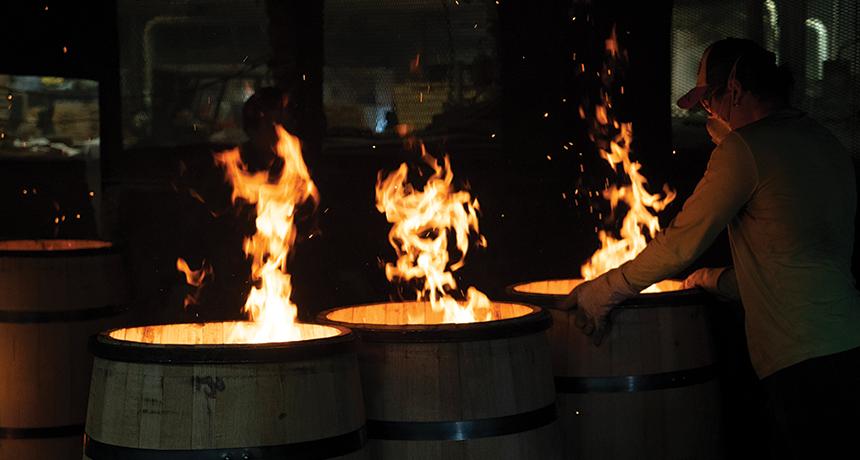
The Art of Non-Alcoholic Spirits
blog
For decades, spirits and cocktails have fostered a culture of craft, connection, and celebration. But over time, cocktail culture has evolved far beyond the buzz!

Written by Shelley Sackier, Director of Distillery Education, Reservoir Distillery
I could write countless articles on the topic of flavor. I could say that as we understand the term today, an easy formula to define it would be scent + taste = flavor.
Or I could argue that biologically speaking, flavor isn't determined only within the oral and nasal cavities; rather it includes parts of the brain, as well as a person's sensory memories, personalized palate, and other internalizations. Really, I like to think of the equation for flavor as a list of five ingredients: we'll keep scent and taste, but we'll also add a dash of touch, past experiences, and expectations. Now that's flavor.
Of course, when we think of flavor in this way, it makes sense why spirit makers take such pains to understand their process, scanning all the components that may contribute both intended and undesirable profiles to their final product. Take it a step further, and you find an impressive list of sources to be mindful of, to play with and utilize, or to do your darndest to avoid.
Here's why wood is a great place to start…
It's believed that a whiskey receives between 50 to 80 percent of its flavor profile from the wood it's aged within. So while it is important to acknowledge the influence of this woody embrace, we should also highlight the impact of those relationships we share with our barrel makers and brokers. To further whittle the field, let's simply focus on the makers-the coopers and the cooperage responsible for engineering and crafting our sacred barrels.
This month, our team at Reservoir Distillery traveled southwest to Atkins, Virginia, to visit the Speyside Bourbon Cooperage-one of Reservoir's highly esteemed barrel makers with wood expertise that originated in Scotland, 1947. It was here that we all had the privilege to meet Josh Chandler, Speyside's plant manager and tour guide extraordinaire. It was also here that we learned just how advanced coopering has become since the days when highly skilled craftsmen practiced the trade by hand.
As an industry, we've come to understand that wood's weighty flavors are derived from the organic compounds located deep within the wood of each barrel. Its cell walls are comprised of cellulose, hemicellulose, and lignin, each of which contribute the qualities we've come to expect and enjoy in our whiskey:
The hemicellulose offers up color and sugars soluble in alcohol, providing the heady notes of caramel. The staves within a barrel, rich with lignin, break down into vanillin, furfural, syringol, eugenol, and lactones-all flavor molecules that give spirits their fruity, nutty, smokey, spicy, and buttery profiles. And one would be remiss not to include the influence of those mouth-puckering, astringent tannins.
Of course, the degree to which these ingredients will present themselves (and therefore affect the flavor profile of your spirit) is dependent upon several factors:
You might notice that the majority of these questions highlight opportunities to experiment with your cooperage if, like the Speyside Bourbon Cooperage, you find yourself with a willing and enthusiastic partner-one who will work to adjust any standard method of barrel raising to create a special recipe for your distillery.
The challenge is deciding where to start first. With countless elements to factor in, will you request something time-tested and results-proven? A cask that falls within the realm of the industry standard and customer approved? Or will you stray outside of those parameters and journey a fresh path like that of a true frontiersman-play with cask shape, alter the toast, the char, or where that heat is concentrated to achieve caramelization?
Will you use a different source of heat-one that might infuse the barrel with flavors unique to its wood? Applewood? Hickory? Peat smoke? An approach to toy with phenols, perhaps?
Will you choose a unique type of wood, pursue oak from lands afar-chasing a distinctively place-based flavor? Or perhaps you wish to move more fully into the land of fringe-like trials and join others searching for methods where your barrel more quickly and efficiently removes some of your spirit's less desirable compounds.
Whether you work with one of the dwindling number of independent coopers remaining in the world (1,500-2,000) or a larger, modern cooperage like Speyside applying, in their words, "state of the art technology and modern manufacturing principles to the age-old craft of barrel making," my point is easy to illustrate: Yes, the world is your oyster-but your cooper is your gatekeeper.
The relationship you foster together may be the key to unlocking not just one new shelf of creativity, but access to an inexhaustible library of choice. Leverage that relationship and perhaps you'll hack the next equation for flavor.
And now, an eye-opening peek into a marvelous carpentry journey you shouldn't miss.
Interested in advancing your knowledge of distilling and the spirits industry? Check out Moonshine University's upcoming courses to learn from the best in the business.
Written by Shelley Sackier, Director of Distillery Education, Reservoir Distillery
Related Content
There's Magic at the Stave Mill: The Ramoneda Brothers

blog
For decades, spirits and cocktails have fostered a culture of craft, connection, and celebration. But over time, cocktail culture has evolved far beyond the buzz!

blog
Those that are familiar with the process of crafting distilled spirits may also be familiar with the 10 common congeners that are created during fermentation, and honed during the distillation run. Each congener has its own distinct personality, rendering unique tastes and aromas to the finished spirit.

blog
So, you want to start distilling with freshly milled grain. Maybe you're tired of paying top dollar for the pre-milled stuff from the malt distributor, and you're ready to invest in the quality, efficiency, and bulk pricing that comes with milling your own whole grain. But where do you start?